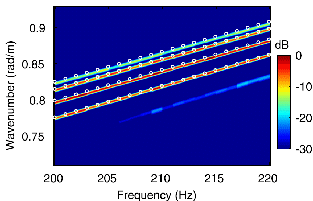Broadband mode extraction, including the horizontal wavenumber and modal depth function estimation, is a classical research task in shallow-water acoustics. Traditional approaches require either a priori waveguide environment, a large-aperture array or a moving source.
Recently, researchers from the Institute of Acoustics of the Chinese Academy of Sciences (IACAS), collaborating with researchers from Scripps Institution of Oceanography, USA, presented a mode extraction method using a vertical line array (VLA) combining multi-frequency information based on block sparse Bayesian learning (BSBL). As one of the compressive sensing methods, the proposed approach did not require a priori information of sea bottom, motions of the source, and source locations (namely range and depth).
Researchers proposed the BSBL based on the fixed point update rule and then extracted the horizontal wavenumbers from the VLA-received broadband signals. In simulations, compared with the KRAKEN calculation, the horizontal wavenumbers estimated by BSBL were in good agreement with the theoretical results. The percentage errors across the frequency band 200~220 Hz for the extracted modes were all lower than 0.3%.
Based on the shooting method, the BSBL could be used for any sound speed profiles of water column. For a typical downward refracting sound speed profile (shown in Figure 1), both the reflected and refracted modes existed in the waveguide. For such a profile, the corresponding ambiguity surface estimated by BSBL along with the theoretical results (circles) were shown in Figure 2. Four evident peaks could be identified from the ambiguity surface, and the peak locations were also in good agreement with the theoretical results of KRAKEN.

Figure 1. (a) Negative-gradient sound speed profile of water column and (b) corresponding phase speed of the first five modes across the frequency band 50~500 Hz. (Image by IACAS)

Figure 2. Ambiguity surface estimated by BSBL along with the theoretical results (circles) for a downward refractive sound speed profile. (Image by IACAS)
The approach was also tested on the experimental data collected in China Yellow Sea in 2000. There were 59 explosive signals along the track with source-VLA range 4.4~56.6 km. The BSBL was applied to these 59 explosive signals with frequency band 200~220 Hz. The obtained wavenumber spectra at 200 Hz for these 59 signals were given in Figure 3(a). For comparison, the wavenumber estimates, based on the simulated data generated by the RAM model, were shown in Figure 3(b). The estimated horizontal wavenumbers between experimental and simulation data were in agreement with each other at most ranges, demonstrating the validity of the proposed method.

Figure 3. The wavenumber spectra estimated by BSBL for (a) experimental data and (b) simulated data at frequency 200 Hz with ranges 4.4~56.6 km. (Image by IACAS)
The method has potential applications in geoacoustic inversion and source localization with extracted horizontal wavenumbers and modal depth functions. It is able to adapt to the shallow-water waveguides for known arbitrary sound speed profiles of water column.
The research was published online in the Journal of the Acoustical Society of America.
Reference:
NIU Haiqiang, Peter Gerstoft, Emma Ozanich, LI Zhenglin, ZHANG Renhe, GONG Zaixiao, and WANG Haibin. Block sparse Bayesian learning for broadband mode extraction in shallow water from a vertical array. Journal of the Acoustical Society of America, vol. 147, no. 6, pp. 3729-3739, June 2020. DOI: 10.1121/10.0001322
Contact:
ZHOU Wenjia
Institute of Acoustics, Chinese Academy of Sciences, 100190 Beijing, China
E-mail: media@mail.ioa.ac.cn


